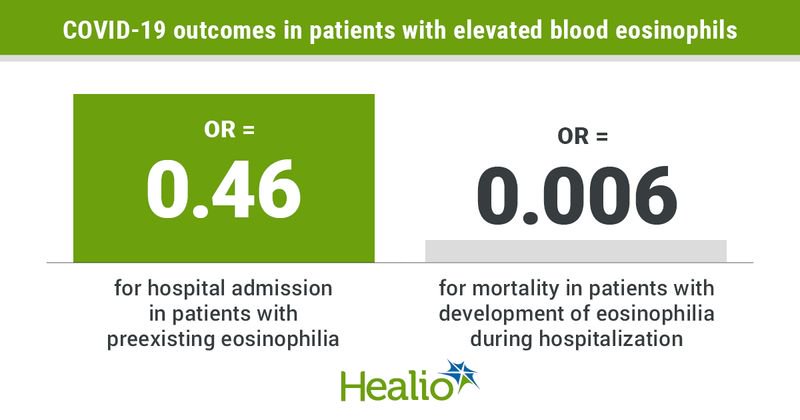Eosinophilia in patients with asthma may be protective against severe COVID-19
Eosinophilia may be an important predictive factor for COVID-19-associated hospital admission and decreased mortality in patients with asthma, according to data published in The Journal of Allergy and Clinical Immunology: In Practice.
“To our knowledge, this is the first study demonstrating a potential protective role of eosinophilia in asthma patients with COVID-19,” Denisa Ferastraoaru, MD, assistant professor in the department of medicine at Albert Einstein College of Medicine and Montefiore Medical Center, Bronx, New York, and colleagues wrote. “The exact role of eosinophils in SARS-CoV-2 infection is not understood.”

The retrospective study included 951 patients with asthma and confirmed COVID-19 (mean age, 60.5 years; 31.8% men) from March to April 2020. The researchers analyzed comorbidities including diabetes, hypertension, congestive heart failure and chronic kidney disease, laboratory results and mortality rates during hospitalization.
A total of 737 (77.5%) patients visited the ED, with 581 (78.8%; mean age, 64.9 years; 35.5% men) of those patients admitted to the ED.
Patients with previously measured mean absolute eosinophil counts of at least 150 cells/µL had a lower likelihood of hospital admission (OR = 0.46; 95% CI, 0.21-0.98; P = .04). Risk factors for hospital admission included concomitant heart failure, chronic kidney disease and COPD.
One hundred four hospitalized patients with asthma had peak hospital-measured absolute eosinophil counts of at least 150 cells/µL. These patients had a lower likelihood of in-hospital mortality compared with patients with an absolute eosinophil count of less than 150 cells/µL (9.6% vs. 25.8%; OR = 0.006; 95% CI, 0.0001-0.64; P = .03) and hospitalized patients with asthma had higher preadmission mean absolute eosinophil count (237 cells/µL vs. 147 cells/µL; P = .001).
In patients with asthma but no associated comorbidities such as diabetes or hypertension, the mortality rate was similar to rates in patients without asthma or any comorbidities (18.4% and 13.5%, respectively; OR = 1.41; 95% CI, 0.28-7.12; P = .6).
“Further prospective and mechanistic studies are needed to explore the exact role of eosinophils in COVID-19 mortality, as well as the influence of different asthma characteristics on outcomes of patients with asthma and COVID-19 infection,” the researchers wrote.

